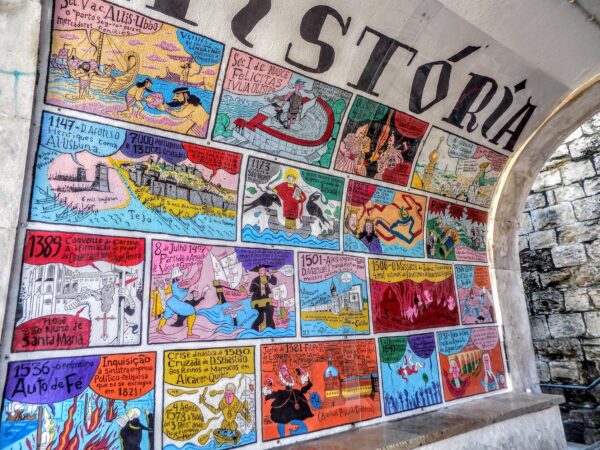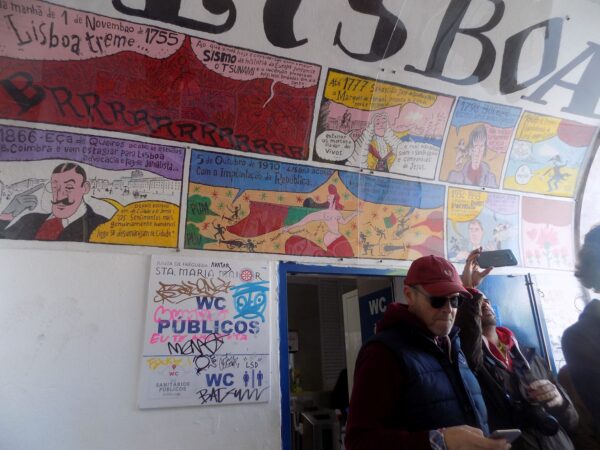By Tuesday, I’d adjusted to one element of life in Lisboa that had previously disrupted my daily rhythm. Attuned to the early morning light, I was now sleeping until close to 08:00. I started the morning with my usual cup of tea, headed out for a fast but relatively short walk of about 1.7 km, and stopped by Pingo Doce to replenish my groceries. Remember, this trip wasn’t simply a vacation but was, in part, an experiment in living in Lisbon so cooking meals at home was an essential part of the experience. And cook, I did. This time it was brunch – a nice omelet and some sautéed baby potatoes.
I then set out from the flat under a bright sunny sky that in summer might have demanded a good dose of sunscreen. My sights were set on the Hospital de Bonecas – the Dolls Hospital. You read that right, the Dolls Hospital.

I’d been in no rush because it was quite close to the apartment – less than half a kilometer to its location on the Praça da Figueira. What I hadn’t counted on was that this was an old, small, family run operation that hewed to the tradition of closing in the middle of the day. I arrived a few minutes past noon and discovered that they were closed for lunch until 15:00. I was mildly aggrieved because while I had other things I wanted to do during the day, the three hour time frame was considerably longer than I expected my other plans required. I did return later in the day but for now it’s off to
Roman ruins and the comic strip mural.
I wasn’t in the best frame of mind when I set off to see something that I can’t imagine exists anywhere but Lisboa. As you might know from my first visit or this visit’s walk up Calçada da Gloria, or simply from looking at many of my photos, the city has developed an interesting way of trying to deal with its graffiti problem by essentially legalizing it in certain places.
While the place I set out to see upon leaving the Hospital de Bonecas was almost certainly not a part of that project, it fits the aesthetic of the city although you’re likely to miss it unless you have a guide who takes you, you’ve researched Lisbon on sites like Atlas Obscura, or you’re taking in the view from the Miradouro Santa Luzia and you need to use the public pay toilet. But more on that in a moment.
I set out on another excellent Organic Maps route that again took me up the Elevador do Castelo (still absent from usage by Google Maps) saving me more than 200 meters in distance and 20 or 30 in ascent. As I climbed the hill up R. de São Mamede I reached this painted wall

and when I stopped to take some pictures, I heard a distinctly American sounding voice behind me say, “You should take a look inside. It’s the excavation of the Roman Theatre.” I turned to thank him and we began to chat. Otenti is originally from North Carolina but currently resides in Lisboa. He told me he’d come to Portugal as a tourist in the late winter of 2020, was stranded due to Covid-19, fell in love with the city, and never left.
As for the Roman Theatre, my research shows that it appears to have been constructed in 10 BCE under the reign of Emperor Augustus and, according to an inscription discovered in the early 18th century was expanded to honor Emperor Nero in 57 CE. After its expansion, it had several tiers and seated as many as 5,000 spectators. Built on the same hill as the Castle, its orientation allowed spectators excellent views of the Rio Tejo.

By the fourth century, as the Empire began to crumble, the theatre was abandoned and, over time, many of its stones were used in buildings around Lisboa as the city grew. The 1 November earthquake in 1755 buried the site for more than two centuries. True archaeological excavations began in the 1960 and it’s now a part of the Museum of Lisboa incorporating two buildings with exhibitions across the street from the site of the dig.
Otenti and I continued chatting. He lived in a building adjacent to the museum and, although he’d been in the city for nearly three years, told me he’d learned very little Portuguese. While I intend to try to develop at least some basic communication skills if I decide to make a second home here, it was reassuring to know that one could certainly get by in Lisbon speaking primarily English. He also clued me in to the visa service he’d used to get his tourist visa extended to allow him to work and be in the country legally.
After our enjoyable (and quite helpful to me) conversation, I briefly looked around the inside of the dig (photo above) and then proceeded on my way to the place I’d set out to see. It was on this part of my walk that I put two incidents together and began synthesizing and internalizing an important life lesson if I can apply it consistently. It’s neither particularly new nor terribly complicated and the TL;DR is: When something frustrates you, let it go as quickly as possible.
You might recall that I expressed considerable frustration at the circuitous uphill walk that I felt I’d been forced to take after the New Year’s Eve festivities. And in the moment, that emotion seemed justified. But later on New Year’s Day, when I set out to get in my 10 km walk for the day, the previous night’s forced march gave me a head start of nearly 3 km and that allowed me to comfortably finish my walk before the skies opened and confined me to my flat. Seemingly bad fortune turned into a benefit.
Similarly today’s events had something seemingly bad become beneficial. Had the Hospital de Bonecas been open when I arrived, I’d have taken that tour and when I reached the Roman Theatre, I might have taken some photos but I certainly wouldn’t have met Otenti and missed an enjoyable, helpful, and informative conversation.
Now, I fully understand that correlation is not necessarily causation and that the temporal proximity of the two sets of events is purely coincidental. With that firmly acknowledged, I will doggedly insist on connecting them and hold on to my newfound belief that there is some force seeking equilibrium and that nothing is gained by holding on to life’s frustrations.
Thus, my TL;DR resolution: You can find life lessons from many sources be that art or even a seemingly trivial event. In this instance it was the latter that told me: When something frustrates you, let it go as quickly as possible.
Now let’s look at my next stop. Sometime in 2013, a local artist named Nuno Saraiva chose to paint the História de Lisboa – a comic strip mural

of what he called, “a cocktail of the not very nice history of Portugal.” He chose the neighborhood because he wanted it in a historic area of Lisbon that represents a crossroads of Phoenician, Roman, and Moorish civilizations. He chose the tunnel because it protects his work from the vagaries of the city’s weather patterns particularly in winter and the even more variable weather that occurs in Alfama. As for my comment about needing to use the toilet,

that’s precisely what the tunnel holds. Thus, you need to know it’s there, have a guide, or need to use the facilities.